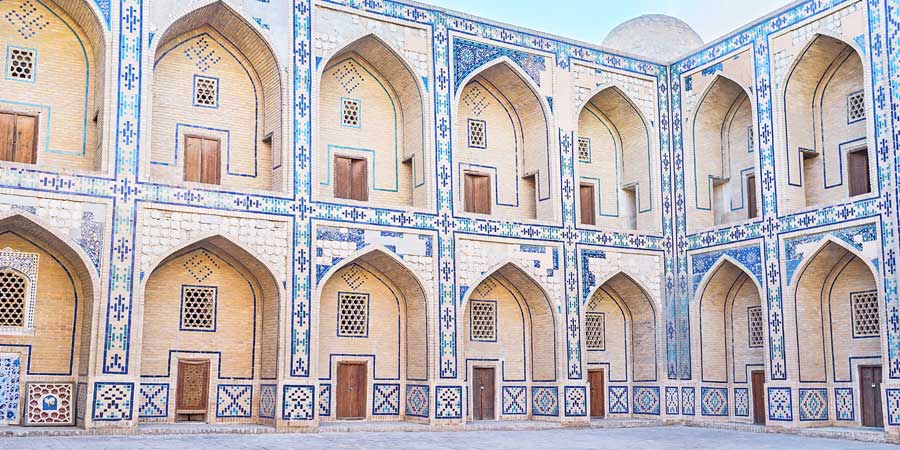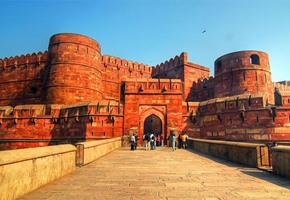There's nothing which quite imbues us with existentialist wonder as an ancient monument from a lost civilisation. Stone and mortar echoes of a time long past, these striking old buildings and structures conjure a sense of awe and majesty with their sombre façades and intricate designs.
Across the world these architectural memories remain thankfully, and at Great Rail Journeys we can't get enough of them. Ancient theatres in Italy, mysterious stone circles in England, dizzying mountain cities in Peru and iconic Indian Mausoleums all feature on our tours, but we've already covered our favourites in blogs past and social media posts of yore.
So this next list is one of lesser-known monuments, a selection of time-worn edifices that lie on the lesser-walked paths in some of the world's most beautiful countries:
Bukhara, Uzbekistan
Found at the heart of Uzbekistan, which lies nestles between various other stans at the heart of the Middle East, the city of Bukhara stands, as if lost in a time bubble. This ancient city is nothing short of a masterpiece of spectacular monuments, standing strong throughout the centuries. The number of architectural wonders line every alley and street corner, gazing down across a beautiful mess of labyrinthine markets and squares. Founded in the 6th century BC, Bukhara is centuries old and its history has created a cultural made from countless civilisations. The city was once a major stop off point on the Eastern-Western Silk Road, and thanks to the economic boom granted by the famous Silk Road trade route, monuments, mosques and palaces sprung up across the millennia. Bukhara became a hub in the Islamic world, proving itself as the intellectual oasis and giving rise to poets, philosophers and scholars. This impressive heritage is celebrated through the magnificent buildings including the Po-i-Kalyan complex, the Chasma-Ayub Mausoleum, and the instantly identifiable Bukhara Fortress, also known as the Ark of Bukhara. The astonishing 140 architectural monuments make this a worthy World Heritage site, protected by UNESCO.
Mir Castle, Belarus
From ancient Islamic history to the brilliant green beauty of eastern Europe, our next monumental building on this list is the fascinating castle complex, Mir Castle. A complete explosion of cultures and different periods in the past, this castle sits amongst some idyllic parklands gazing across the shimmering pure waters of a miniature lake. Equally beautiful in spring, summer, autumn and winter, this is the Socratic form of the fairytale fortress. Its turrets, the flowers, the terracotta tipped off with white - the Mir Castle has everything bar a dragon, a knight and a princess. Built in the 16th century by a duke named Duke Ilinich, the original design was meant to be Gothic but after the death of the duke, the castle changed hands to an aristocrat names Mikolay Radziwil. Radziwil, continued working on the castle, but altered the design to include the trendier Renaissance style of architecture which was popular at the time. Nowadays, the Mir Castle is undergoing renovation works, and is open to tourists, many of whom visit from the nearby Belarusian capital of Minsk. It earned its UNESCO heritage status in 2000.
Shibam, Yemen
Skyscrapers? We all know them. The crystal trees that lift up the concrete jungle into the sky. But take yourself out to the fortified city of Shibam in the governorate of Hadhramaut in central Yemen and that idea of a high-rise city is thrown out the window. Rising, mirage-like from the surrounding sands, Shibam is famous for its tall mudbrick towers which ascend to dizzying height. This magnificent city looks like the ancient Egyptians or Babylonians saw the skyline of New York and decided to have a go themselves. It's not for nothing that Shibam is known around Yemen as the 'Manhattan of the Desert'. Dating back to as far as the 3rd century AD, Shibam, the skyline began growing to its fantastic proportions around the 16th century. Similar to Bukhara, the rich traders who passed through gave over much of their wealth to this city which they used as a place to escape the Bedouin raiders of the area. The fortified walls provided much of the defences, and thanks to these walls and the impressive buildings, Shibam was granted UNESCO World Heritage status in 1982.
Old Town Lunenburg, Canada
We're going to tone it down a little with the last offering, to finish our list off. We cross across to the New World to pay a visit to the charming and quaint Lunenburg in Nova Scotia in Canada. Looking almost like part of Norway or Sweden has broken off and drifted across the Atlantic, Lunenburg is full of enchanting colourful houses and building look across the content blue of the Canada Coast. A true maritime town, Lunenburg's history has seen it be the focal point through various wars, and each nation which has passed through has left an indelible mark. None more so, than the fantastic colonial buildings which originated in the 17th century. Many of these are coloured in vibrant pinks, green, yellows and blues lending fantastic colour to the wild and rugged island of Nova Scotia. One of only two urban areas in North America designated as UNESCO World Heritage sites, the old town of Lunenburg earned the title in 1995.






